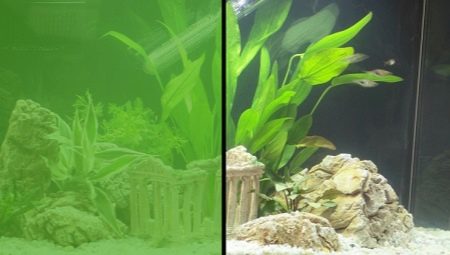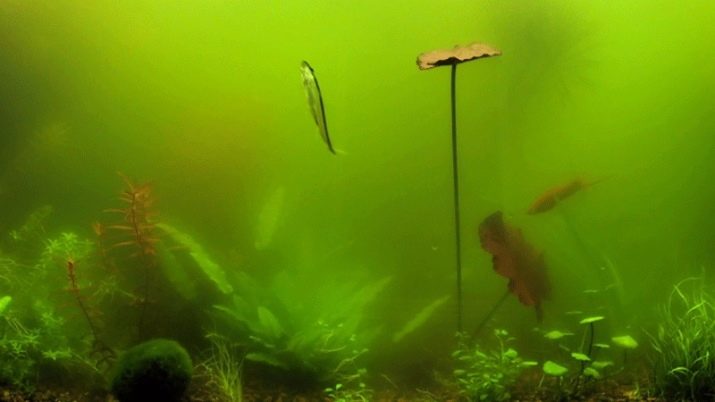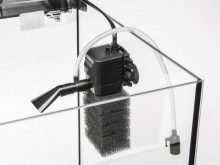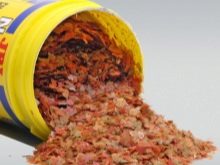Why does the water in the aquarium turn green and how to deal with it?

A responsible aquarist, noticing a slight greening of the water, will not wait for the greenery to cover the entire space of the tank, but will try to solve the problem as soon as possible. But first, it is important to find out what caused this phenomenon and eliminate the root of the problem, and then regularly take preventive measures.


Why is green water dangerous?
Every aquarist is probably familiar with greening water. The phenomenon is the uncontrolled development of phytoplankton. An artificial reservoir acquires green color under the influence of the abundance of pigmented cells. Sometimes the color of the water can turn yellow-brown or reddish. Phytoplankton can be compared to ordinary algae, which, unlike known plants, does not grow on the walls of the aquarium, but multiplies in the water column.
You should not be very afraid of him. Small amounts of these microscopic organisms will not harm aquarium inhabitants, but they can disrupt the biobalance by taking useful elements from aquarium plants. In the process of proliferation, phytoplankton changes water parameters and worsens the development of green spaces, as a result, this process leads to a significant reduction in oxygen in the water, and this can already negatively affect the state of animals and fish.
The danger of green water lies in the fact that as phytoplankton multiply, the reservoir becomes more and more turbid., and soon it becomes impossible to see the aquarium world through the green dregs. The owner may not notice the poor condition of the fish in time and miss their illness.
Finally, greening in the aquarium significantly spoils the appearance of an artificial reservoir, making it unkempt and abandoned.

Main reasons
There are several reasons for this problem. Most often, the following factors lead to greening.
- Excess organic components. During decay, the waste products of aquarium inhabitants, dead leaves and parts of exfoliated shells release nitrogenous compounds into the water, which phytoplankton feed on. The more decaying fragments, the faster the unicellular algae spreads, and the faster the water turns green. You can find out what the abundance of organic matter led to the negative process by a large amount of fish excrement and the remains of molt of armored animals. By the way, this process not only provokes the development of microorganisms, but also becomes a source of poisoning in the reservoir, which reduces the quality of water.
- Excess light. One of the most common reasons. Usually, the water turns green in the aquarium, which is located under ultraviolet rays. That is why aquarists forbid placing the container on the south or southeast window. The development of microalgae is also caused by powerful lighting equipment that works longer than 12 hours a day.
- Defective filter. Weak filtration systems can also cause the water to turn green. A poorly working filter, designed for a smaller volume than is actually used, is unable to fully eliminate contamination. Uncleaned debris becomes a tasty food for unicellular algae. A filter that is rarely cleaned leads to the same process.
- Abundance of vegetation. Until the lighting is turned on, plants are engaged in the production of carbon dioxide in the dark. This element is extremely important for the development of phytoplankton. In this regard, a large number of green spaces leads to the multiplication of microorganisms.
- Elevated temperature. The optimum temperature range for aquarium animals and plants is 22-26 degrees. With an increase in performance, unicellular algae spread very quickly throughout the entire water column. You can tell the cause by looking at the aquarium thermometer.
- Bad cleaning. This becomes the reason not only for the reproduction of algae, but also for fish diseases. Cleaning should be of high quality and regular. The smaller the tank capacity, the more frequent cleaning it needs. So, a 15-liter aquarium needs to be cleaned weekly, and a 100-liter artificial reservoir requires cleaning once a month. The process consists in cleaning the walls from green plaque, thinning and pruning overgrown plants, cleaning the soil siphons, and cleaning the filter.
- Incorrect replacement. The novice aquarist is not immediately involved in the process of caring for the aquarium and at first may change part of the water too rarely or often. And in fact, and in another case, the reproduction of unicellular algae is possible. It is important to take water changes responsibly.
- Poor fish feed. Poor food powder, uneaten by the fish, settles to the bottom, where it begins to decompose. This process becomes a factor in the spread of a colony of microscopic algae.



How to deal with this?
When the bloom of aquarium water has become serious, it is required to relocate all residents. The fish can be temporarily placed in another tank with the same water characteristics. For plants, a container is enough, where methylene blue is added. If the water is just beginning to turn green, then it is possible not to expose the aquarium inhabitants. Fighting green algae can take time. This can be done in different ways.
Natural cleansing
Plaque formed on the walls of the aquarium can be destroyed by live "orderlies", for example, catfish. Snails, platies, mollnesia can take part in cleansing.Planktonic crustaceans become frequent inhabitants of aquariums, which also cleanse the reservoir of microorganisms by passing and filtering water through themselves. If the choice of the aquarist fell on crustaceans, then populate them in large numbers, since these creatures always become a delicacy for predatory fish.
Living "filters" are able to remove greenery from decorations, walls of the aquarium, soil. This method will become even more effective if for the period of cleansing you reduce the portion of food for the fish, reduce the length of daylight hours and turn on the aeration systems at high power.


Mechanical method
To get rid of greenery mechanically, heed the recommendations of experienced aquarists.
- Put a high-quality filter in the tank, the power of which corresponds to the volume of the container. Clean all hoses, tubes and sponges that make up the device regularly. If it is an outdoor unit, it may need to be cleaned less frequently. The internal filter needs to be cleaned weekly.
- To reduce the spread of unicellular algae, install a special ultraviolet sterilizer, and also equip the aquarium with a diatom filter, which will more effectively clean the artificial reservoir of harmful microorganisms.
Remember to periodically scrape off any green deposits from the surfaces.

Chemicals
Experienced fish lovers prefer to combine the mechanical method and the use of chemicals. The introduction of chemistry helps to suppress the development of phytoplankton. The most popular remedies are as follows.
- Hyacinth. According to the instructions, the drug is added to water in a ratio of 1 ml to 10 liters of water. As soon as the microorganisms die under the influence of the agent, they are eliminated by the filtration system.
- Streptomycin. It is an antibiotic. Eliminates any type of unicellular algae. Diluted in the amount of 3 mg per 1 liter of water.
- Erythromycin. Also belongs to the class of antibiotics. To combat phytoplankton, you need to add 250 mg of the drug per 100 liters of water.
According to aquarists, these products are safe for aquarium inhabitants and do not need to be reprocessed.


Traditional methods
Some aquarists turn to folk recipes for help. For example, a 3% solution of boric acid can overcome greens. The drug is added to the aquarium in a proportion of 1-2 ml per 1 liter of water.
Prevention measures
It is usually easier to prevent the problem than to overcome it. Therefore, in order to avoid the spread of phytoplankton, it is important to take preventive measures. To prevent the water from blooming, maintain a normal microclimate in the artificial reservoir. This can be achieved by the following actions.
- Place the tank out of direct sunlight.
- Before starting the aquarium, place the soil slightly at an angle so that a low hill forms at the front wall.
- The optimum power of lighting devices is 0.5 W per 1 liter of water. Shade the aquarium occasionally to keep algae from overgrowing.
- Place a lid on the aquarium to keep out dust and debris. Check the serviceability of the aeration and filtration systems.
- Change the water every two weeks. It is important to remove 30% of the total volume and change it to fresh water that has settled during the day. In this case, the new water must be at the same temperature. Drain and fill with a siphon - then the dregs will not rise in the aquarium.
- Buy quality food for your fish and add portions of it in such an amount that the fish can eat it in 5 minutes. It is important to remove all uneaten residues in time.
- Do not overpopulate the aquarium with fish and plants. The flora releases too much carbon dioxide into the water, and a lot of waste from a large number of aquarium inhabitants remains. All these factors lead to the formation of phytoplankton.
- Monitor the condition of the aquarium at all times.
Examine plants and decorations for the presence of green bloom, observe the activity of fish, monitor the maintenance of the microclimate, control the temperature regime.


For information on why the water in the aquarium turns green and how to deal with it, see the next video.








